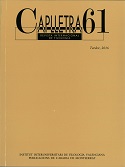A diachronic study of the (negative) additive anche in Italian
DOI:
https://doi.org/10.7203/caplletra.60.8456Palabras clave:
additive, negative additives, focus, aspectual marker, grammaticalization Resumen
Resumen
Abstract: In Modern Italian (MI), negative additives are focalizing elements that typically obey negative concord with a clausal negation or another licensing negative element. In this paper we investigate the diachronic evolution of one negative additive element, neanche ‘neither/not even’. In Old Italian (OI, Florentine variety of 1200-1370), there is no evidence of morphologically complex negative additive focalizers such as neanche. Instead, the non-negative additive counterpart of neanche, anche, could combine with a negative marker or some other negative element: e.g. né/non… anche ‘neither/not even’. We show that, in OI, (i) the morphologically non-negative additive anche can be used both as a negative and as a positive polarity item; (ii) anche can function either as an aspectual marker with the meaning ‘(not) yet’, or as an additive focalizer with the meaning ‘neither/not even’; (iii) its different interpretations are mirrored by different syntactic positions, i.e. anche has an aspectual interpretation in the postverbal position taking scope over a verbal phrase (vP), and it has an additive interpretation in the preverbal position taking scope over a determiner phrase (DP); and (iv) anche triggers a focus semantic interpretation under both conditions: as an additive and an aspectual marker (see Rooth 1985, Chierchia 2013 on focus semantics).
We account for the diachronic evolution from neg(ation) + anche in OI to neanche in MI by suggesting that the grammaticalization of neanche originates from a particular construction in which the additive anche is immediately to the right adjacent to the negative disjunction né (i.e. né+anche>neanche).
Key words: additive, negative additives, focus, aspectual marker, grammaticalization.
 Descargas
Descargas
Descargas
Publicado
Cómo citar
-
Resumen817
-
PDF (Català)338
Número
Sección
Licencia
El autor o autora que dirija un trabajo a la redacción de Caplletra para ser publicado tiene que ser la persona titular legítima de los derechos de explotación. La legitimación para la publicación del trabajo tiene que incluir también las imágenes, las tablas, los gráficos y otros materiales que puedan complementar el texto, con independencia de si es su autor o autora.
Copyright. Al publicar el trabajo en la revista, el autor o autora cede a Caplletra. Revista Internacional de Filologia los derechos de explotación (reproducción, distribución y comunicación pública), tanto para la edición impresa en papel como para la versión electrónica.
Todos los trabajos publicados en Caplletra se encuentran bajo una licencia Creative Commons del tipo Reconocimiento-NoComercial-SinObraDerivada 4.0.
RESPONSABILIDAD
Caplletra. Revista Internacional de Filologia no se identifica necesariamente con los puntos de vista sostenidos en los trabajos que publica.Caplletra. Revista Internacional de Filologia declina toda responsabilidad derivada de cualquier vulneración eventual de los derechos de propiedad intelectual que pudiera ser llevada a cabo por los autores o autoras.






